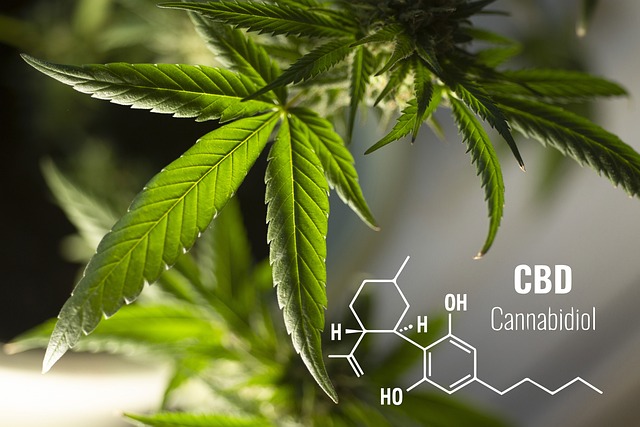High potency cannabinoids are emerging as promising therapeutic agents due to their distinct effects on the human endocannabinoid system, potentially benefiting a range of medical conditions with analgesic and anti-anxiety properties. The unique advantage of these compounds is their high precision and potency, allowing for targeted engagement with specific body receptors, leading to more controlled dosing and predictable therapeutic outcomes. Their legal status has been influenced by recent legislation like the U.S. Farm Bill, which has facilitated research and development, including FDA-approved cannabinoid-based medications. Patient data and clinical trials support their effectiveness in managing chronic pain, anxiety, and epilepsy, and they are increasingly being recognized for improving quality of life. Ongoing advancements focus on developing these therapies further to optimize their use with fewer side effects. The commitment to clinical trials, basic science research, and the development of advanced drug delivery systems is essential for establishing the safety and efficacy of high potency cannabinoids, which hold promise for revolutionizing medical treatment in the future.
Exploring the therapeutic benefits of high potency cannabinoids in medicine reveals a promising landscape for patients seeking alternative treatments. This article delves into the scientific underpinnings of how these compounds interact with our bodily receptors, comparing the effects of THC and CBD, and examines the rise of synthetic alternatives within clinical practice. As we navigate through legal constraints governing their use, patient experiences provide valuable insights into real-world applications. Ahead, we chart the course of research and development in high potency cannabinoid therapies, offering a comprehensive overview of this burgeoning field in medical science.
Unlocking the Therapeutic Potential of High Potency Cannabinoids in Medicine

High potency cannabinoids hold significant promise for therapeutic applications in medicine due to their distinct pharmacological properties and capacity to interact with the human endocannabinoid system. Research into these compounds has revealed a wide array of potential benefits, ranging from pain relief to anti-inflammatory effects, and even neuroprotective properties. Scientists are particularly interested in cannabinoids like THC (tetrahydrocannabinol) and CBD (cannabidiol), among others, for their ability to modulate various physiological processes. For instance, THC has been found to be an effective analgesic, while CBD exhibits anti-anxiety and anti-epileptic qualities without the psychoactive effects associated with THC. The therapeutic potential of these compounds is further enhanced by their versatility in formulation, allowing for precise dosing tailored to individual patient needs. As regulatory frameworks evolve and more clinical trials are conducted, the integration of high potency cannabinoids into standard medical practices has the potential to offer new treatments for a multitude of conditions, thereby improving health outcomes and quality of life for patients.
The Science Behind Cannabinoid Receptors and Medical Efficacy

The therapeutic properties of cannabis are increasingly being recognized and understood through scientific investigation into its high potency cannabinoids, particularly THC and CBD. At the core of this understanding is the interaction between cannabinoids and the human endocannabinoid system (ECS), which maintains homeostasis in the body. The ECS comprises a network of receptors, with cannabinoid receptors CB1 and CB2 being the primary points of interaction for phytocannabinoids from the cannabis plant. These receptors are found throughout the body, with CB1 predominantly in the central nervous system and CB2 primarily in the peripheral systems, especially immune cells.
The efficacy of medical marijuana is significantly tied to the engagement of these receptors by cannabinoids. For instance, THC (tetrahydrocannabinol) binds preferentially to CB1 receptors, affecting neurotransmitter release, appetite, pain sensation, and memory, contributing to its therapeutic effects for conditions like chronic pain, nausea, and neurological disorders. On the other hand, CBD (cannabidiol) interacts with both CB1 and CB2 receptors, and other receptors outside the ECS, such as serotonin receptors, offering a broader range of medical applications. Its non-psychoactive nature makes it particularly promising for treating conditions like epilepsy, anxiety, and inflammation without the psychotropic side effects associated with THC. The precise mechanisms by which high potency cannabinoids exert their therapeutic effects continue to be a focus of research, with ongoing studies aimed at elucidating their potential and optimizing their use in medical treatments.
THC vs CBD: Understanding the Roles in Medical Treatment

High potency cannabinoids such as THC and CBD have garnered significant attention in the medical community for their therapeutic properties. Tetrahydrocannabinol (THC) and Cannabidiol (CBD) are two of the most prevalent compounds found in the Cannabis sativa plant, each with distinct effects on human health. THC, known for its psychoactive effects, has been extensively studied for its role in pain management, particularly neuropathic pain. Its ability to influence neurotransmitter release, modulate endocannabinoid receptor activity, and reduce inflammation makes it a potent analgesic. In contrast, CBD is non-psychoactive and exhibits a wide range of potential therapeutic applications, including the treatment of epilepsy, anxiety disorders, and as an anti-inflammatory agent. Its interaction with the endocannabinoid system affects various physiological processes without the psychoactive side effects associated with THC.
The medical use of high potency cannabinoids often involves a careful consideration of each compound’s properties to optimize treatment outcomes. For instance, a combination of THC and CBD can offer a balanced therapeutic effect, where THC may provide relief from pain and improve appetite, while CBD can mitigate some of the psychoactive effects of THC and enhance its beneficial properties. The precise dosing and ratio of THC to CBD are crucial in achieving the desired medical benefits, as these can vary significantly depending on the individual’s condition and response to treatment. Ongoing research continues to elucidate the mechanisms behind these cannabinoids, with the aim of developing effective, safe, and personalized treatments for a multitude of medical conditions.
The Emergence of Synthetic Cannabinoids in Clinical Settings

The medical community has seen a significant shift with the emergence of synthetic cannabinoids in clinical settings, offering new therapeutic avenues for various conditions. Unlike traditional cannabis, which contains a wide array of cannabinoids with varying potencies, synthetic cannabinoids are created to target specific receptors in the body with high precision and potency. This advancement allows healthcare professionals to administer treatments with more controlled dosages and predictable outcomes, which is particularly beneficial for patients requiring precise therapeutic concentrations. These compounds have been designed to mimic the effects of naturally occurring cannabinoids but can be tailored to possess greater efficacy or reduced side effects, making them valuable tools in the treatment of chronic pain, inflammation, neurological disorders, and other ailments where conventional treatments may fall short. The research and development in this field are ongoing, with the potential for synthetic cannabinoids to play an increasingly important role in optimizing medical care and patient outcomes.
Navigating Legal Landscapes: The Status of High Potency Cannabinoids for Medical Use

In recent years, the exploration and utilization of high potency cannabinoids for medical purposes have gained significant traction. The legal landscapes surrounding these compounds are complex and vary widely across different jurisdictions. In the United States, for instance, the Farm Bill of 2018 legally defined hemp, which contains less than 0.3% THC, and its derivatives, making it easier to research and develop high potency cannabinoids like CBD and CBN with therapeutic potential. However, despite this progress, navigating these legal waters remains a challenge due to the evolving regulatory environment. The Food and Drug Administration (FDA) has approved certain cannabinoid-based medications for specific conditions, signaling a shift towards broader acceptance of these compounds in healthcare. Patients and researchers alike are closely monitoring the development of regulations that govern the use of high potency cannabinoids, as their potential applications span a wide range of medical conditions, including pain management, seizure disorders, and anxiety relief. The key to advancing the medical use of high potency cannabinoids lies in understanding the nuances of legal compliance, staying abreast of scientific advancements, and ensuring that clinical trials are designed to provide compelling evidence of their efficacy and safety. As such, stakeholders are increasingly focused on the legal and regulatory frameworks that will ultimately dictate the extent to which high potency cannabinoids can be harnessed for medical benefits.
Patient Experiences and Real-World Applications of High Potency Cannabinoids

Patients across various demographics are increasingly exploring the therapeutic benefits of high potency cannabinoids for a multitude of conditions, from chronic pain to anxiety and epilepsy. Clinical trials provide structured evidence, yet real-world applications offer invaluable insights into how these compounds interact with different individuals. Real-world data showcases the efficacy of high potency cannabinoids in managing symptoms that have been resistant to traditional treatments. Patients report improved quality of life, with a notable decrease in pain levels and an enhanced ability to function on a daily basis. The subjective nature of these reports highlights the importance of individual experiences in guiding treatment decisions. As such, healthcare providers are encouraged to consider patient-reported outcomes alongside clinical trial data when advising on cannabinoid use.
The applications of high potency cannabinoids extend beyond their medicinal properties; they are also being integrated into various wellness practices. In this realm, users often seek relief from stress and fatigue, or aim to support overall health and well-being. The diversity of patient experiences underscores the potential for these compounds to be used as a complementary therapy across different populations. However, it is crucial for further research to continue elucidating the mechanisms behind their effects, ensuring safe and effective use. The integration of high potency cannabinoids into mainstream medical practice relies on a robust evidence base that aligns with patient narratives, thereby validating the anecdotal success stories and guiding clinical recommendations.
Future Directions: Research and Development in High Potency Cannabinoid Therapies

Research into high potency cannabinoid therapies is a burgeoning field that holds significant promise for medical applications. As scientific understanding of the endocannabinoid system deepens, researchers are identifying novel ways in which cannabinoids can be harnessed to treat a variety of conditions. The focus on high potency formulations aims to optimize therapeutic effects while minimizing side effects, thereby enhancing patient outcomes. Future research will likely explore the precise mechanisms by which these compounds interact with the body’s systems, leading to more targeted and effective treatments. Additionally, advancements in drug delivery systems are expected to improve the bioavailability and onset of action of cannabinoid therapies, making them more efficient and reliable for clinical use. As the regulatory landscape evolves, supporting research and development is crucial to unlocking the full potential of high potency cannabinoids in the medical domain. This will involve rigorous clinical trials to establish safety and efficacy, as well as a continued investment in basic science to expand our knowledge of cannabinoid receptors and signaling pathways. The commitment to innovation in this field promises to pave the way for transformative treatments that could significantly impact patient care.
